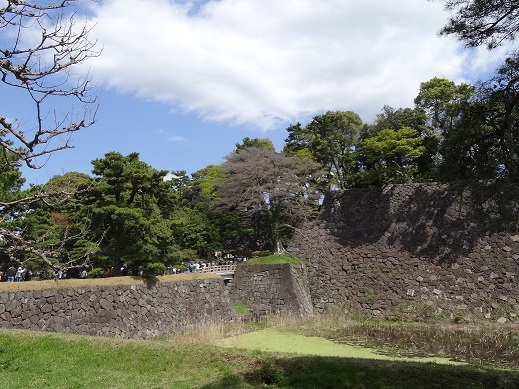|
The Imperial Palace
|
The Imperial Palace is located at Marunouchi, Tokyo, whichi was the west, the "Momijiyama" and "Fukiage" baileys of the ruins of Edo Castle.
During the Edo Age
(1603 - 1868)
, "Shoguns" lived in Edo Castle and Emperors had lived in the previous Imperial Palace, located in Kyoto, since 794.
After the Edo Age finished in 1868, Edo Castle was abandoned and a part of the Edo Castle became the Imperial Palace and Tokyo became the capital of Japan.
The Imperial Palace in Tokyo is not open to the public, except on the second day of a new year, the birthday of the Emperor and special openings for a few days during the year. However, you can visit the Palace Plaza.
If you are lucky enough, you can to see a parade of carriage with a guest of the Emperor.
|
The Parade of Carriage

|
View of "Nijyubashi" Bridge

|
|
Also, you will see the "Fushimi" Turret at the west bailey and the "Nijyubashi" bridge at Palace Plaza.
The "Nijyubashi" Bridge is the entrance of the Imperial Palace. The view of the "Fushimi" Turret and the "Nijyubashi" Bridge is one of representative views of Japan.
On the second day of the new year and the birthday of the Emperor, public can visit the Imperial Palace to cerebrate new year through "Nijyubashi" Bridge. The below picture shows the "Fushimi" Turret from the "Nijyubashi" Bridge. It is said that "Fushimi" Turret was moved from Fushii Castle in Kyoto, which TOYOTOMI Hideyoshi
(1537 - 1598)
built.
You will enter the Imperial Palace from the "Otemon" Gate of the west bailey.
The west bailey was built in 2005 for TOKUGAWA Ieyasu's
(1543 - 1616)
private castle after his retirement.
After passing through the "Otemon" Gate of the west bailey, you will walk up a slop to the Imperial Palace.
You will see "Fushimi" Turret on your left. After crossing the "Nijyubashi" Bridge, the site of "Shoinmon" Gate is the final barrier to the Imperial Palace.
|
The view of "Fushimi" Turret

|
|
The site of "Shoinmon" Gate

|
|
The Emperor and the imperial family show up at most five times to celebrate the new year.
As average, 70,000 people come to the Imperial Palace on January 2nd and the Emperor's birthday, respectively.
|
|
The new year celebration at the Imperial Palace
|
|
|
|
|
The Emperor and the imperial family are very elegant.
The Emperor is a symbol of Japan. However, before World War II, the Emperor was considered as living god and had all the power and the authorities under the Imperialism. The Imperialism in Japan from 1868 led Japan to invade eastern and south eastern Asian countries and generated Word War II.
I believe the Emperor regrets the ignominious history and prays for permanent peace. On the other hand, there are so many imperialists in Japan, including the prime minister of Japan since 2012. They wish Japan to become as it was during Word War II. It is a big concern.
When the Emperor and the imperial family showed up to the public, many people shouted as "Banzai".
"Banzai" means the word to admire the Emperor and to wish his permanent prosperity.
However, I must note that you should not forget that many young solders made suicide attacks and residents in Okinawa were forced to make mass suicide, while they were forced to say "Banzai" at the last minutes of their lives.
In addition to January 2nd and the Emperor's birthday, the Imperial Palace is now open to the public in spring and in the late autumn. These special openings started in 2014, as the Emperor's presents to the public to enjoy cherry blossoms and colored leaves of trees in the Imperial Palace.
In the case of special openings, the "Sakashitamon" Gate is the entrance.
You walk straight ahead to the "Inui" Avenue.
In spring, you will see cherry blossoms along the avenue.
|
|
Cherry blossoms along the "Inui" Avenue
|
|
|
|
|
Double cherry blossoms were full of bloom and very beautiful.
You will also see the "Fukiage" Area in the Imperial Palace. Their Majesties the Emperor and Empress live there. The moat shown in the bellow picture is named "Dokanbori" Moat, named after OTA Dokan
(1432 - 1486)
who built the Edo Castle in 1457.
On the right side of the "Inui" Avenue, you will see the Inner Moat. High stone walls of the main bailey remain from the Edo Age.
There is an earth-paved bridge to the main bailey at the north end of the Inner Moat.
|
The Earth-Paved Bridge

|
"Fujimi-Tamon" Defence House on Stone Walls

|
|
This scenery can be seen only during the special openings in spring and fall. The opening dates depend on when cherry blossoms or colored leaves are beautiful. In the past, the special openings have been held between the end of March and the beginning of April in spring and at the beginning of December in autumn, for usually five days. If you are in Japan during these days, please do not miss these opportunities.
|
|
|
How to get there
the Imperial Palace is located at Marunouchi in Tokyo. Tokyo Station on JR Lines, and Otemachi and Nijyubashi Stations of Tokyo Metro are the nearest stations.
Official English Website:
The Imperial Household Agency
Other Historical Sites near by:
Edo Castle
Hibiya Park
"Hama-Rikyu" Garden
Zoujyoji Temple
|
|


 Home Page in Japanese: "Shane's HomePage"
Home Page in Japanese: "Shane's HomePage"


 Home Page in Japanese: "Shane's HomePage"
Home Page in Japanese: "Shane's HomePage"